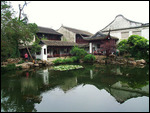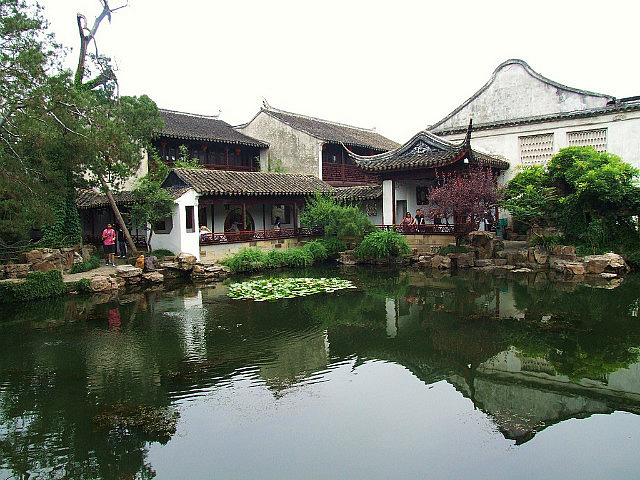In the grand scheme of things Suzhou nowadays is just another prosperous medium-sized city in the Yangtze Delta region. This is one of the most developed and wealthy regions of China, a region criss-crossed by thousands of miles of waterways that not only guaranteed crop yields but also provided foundation for trade and industry. Before Shanghai stole the show in recent centuries, Suzhou and Hangzhou were the leading cities of the region and the center of silk manufacture in China for a thousand years. Its mild climate and prosperous lifestyle attracted many intellectuals and artists over the ages, who perfected the fine art of Chinese gardening. A Chinese saying goes: "In heaven there is paradise, on earth there are Suzhou and Hangzhou".
We took a high-speed train from Nanjing to Suzhou, a distance of 214 km that took just over an hour. This high-speed service was only rolled out on July 1st, so we were one of the first people to enjoy it. I had been to Suzhou once before, but had only visited its two major gardens. This time we're here for more. We first headed to the Blue Wave Pavilion, one of the smallest classical gardens of Suzhou. Luckily this is not one popular with tour groups, so serenity reigns in this well-designed garden. As we walked along the meandering footpaths and covered galleries, we were frequently surprised to find unexpected views over gnarled trees, peaceful courtyards, lush plantings, filigree windows, graceful pavilions, elegant rooms with antique furniture, ponds with swimming koi, and sculpture-like rocks. These individual vignettes were each exquisite and subtly stimulating. Because one side of the garden borders a canal instead of a wall, one gets the illusion of having a much larger garden.
We then headed to the Master of Nets Garden, a larger one with many courtyards and a larger central pond. Having ample space its design is not as crafty to maximize visual space like the Blue Wave Pavilion. The best thing about this garden are the many imposing houses, gateways, and courtyards with intricate architectural detail. One of the houses hosts an art gallery, where we spent quite a while perusing paintings by local artists while it rained outside. Exquisitely detailed roof lines and walls are another great feature of this garden.
Next we visited the Suzhou Museum, which was designed by internationally renowned architect I. M. Pei. using the gardens of Suzhou as inspiration. Although modern in outward form, its many vignettes, its color, and its interior spaces complete with water falls and koi ponds are reminiscent of the classical garden. This was an excellent museum similar in its displays to the Nanjing Museum we saw the day before. What's more fascinating was that the former palace compound of a Taiping rebel prince is part of the museum, accessed via a side gate. We enjoyed walking through the many courtyards with cozy gardens and fish ponds, and stumbled upon a beautifully restored in-door theatre with period furniture.
When we went to the Lion Grove Garden, there were so many tour groups left and right it was unbearable. The crowds destroyed the serenity, blocking the narrow paths and disrupted the sightlines. We quickly left the place. We also roamed the side streets of Suzhou, walking in on a canal-side neighborhood party, and strolling along the restored Pingjiang street (a narrow alley without cars) lined by attractive boutiques and quaint tea houses. The canals define Suzhou - often compared to Venice, although architecturally much more laid-back. The lack of traffic was wonderful, and locals were easy-going but sophisticated. We saw blue skies in Suzhou, as well as a torrential downpour, all in the same day!

